Abstract
The rural construction community embodies a confluence of social dynamics within rural areas, constituting an organic self-organization with hierarchical relationships. Over a specific period, the amalgamation of various roles and relationships within the rural construction community shapes the prevalent culture, distinctive image, and production techniques within villages. This study examines the structural composition of village communities and endeavors to establish a linkage mechanism among different elements within the construction framework. Focusing on villages and their inhabitants, this research traces the temporal evolution along the following axes: (1) Traditional Agricultural Civilization Age; (2) Collective Economy Age; (3) Rural Industrialization Age; (4) Rural Differentiation Age; and (5) Rural Revitalization Age. This paper primarily observes the evolution through the cultural foundation and manifestation of rural communities, emphasizing that the communities represent cooperative, autonomous, and transformative constructs. From the perspective of cultural landscapes, this article elucidates the interconnected trajectory of ecology–institution–livelihood in the creation of rural communities. It interprets the interplay among the resource patterns, social structure, and economic forms of villages across five distinct periods, fostering a comprehensive understanding of rural community development amidst changing circumstances. Recent years have seen a concerning decline in rural areas, where rural community culture faces a significant impact from modern industrial civilization, resulting in the disintegration of the social fabric within community construction. Nevertheless, the resilient common sense and self-organization capabilities of villagers persist. This study seeks to offer theoretical guidance and decision-making support to advance innovative social governance in rural locales. Moving forward, China’s rural revitalization demands a more adaptive sustainable assessment within rural construction communities.
1. Introduction
1.1. Explanation of Core Concepts
1.1.1. Concept Explanation of Rural Construction Community
Tonnies believed that communities rooted in instincts or habitual constraints of individuals constitute the most fitting, enduring, and authentic forms of life. Strong ideological attributes and ideologies endow communities with robust vitality in rural areas. Constructing rural communities is a vital component of village social entities, referring to a specific region’s population mutually aiding and relying on each other in their methods of production, daily affairs, and housing construction activities. This article posits that constructing rural communities can spiritually identify with the collective spirit of a population. Moreover, it can self-adjust and self-develop in response to the changing times, constituting the social organization of modern rural areas. Rural community construction embodies both organizational and non-individual characteristics. Therefore, this article focuses on studying how rural community construction, when faced with social changes, integrates a broader range of social resources for village and community development.
1.1.2. Perspective of Rural Construction Community
This article interprets the historical process and developmental paradigms of rural China using the theoretical framework of constructing rural communities. Through the lens of constructing rural communities, it observes the evolution of rural living environments to explore the role played by rural community construction as a tool for controlling regional societies. It scrutinizes the inherent correlations between rural community construction and the historical changes within regional societies.
1.2. History and Background
In China, villages represent the residential areas within rural regions. They form fundamental social systems integral to the country’s geography, social fabric, and organizational rules. For millennia, the social system centered around villages have profoundly influenced China’s societal evolution [1]. Even today, amid China’s robust promotion of Rural Revitalization, the sustainable development of villages hinges on the comprehensive reparation of their social systems [2,3]. Social systems compass diverse integrations of roles and relationships, akin to intricate networks [4]. Presently, Chinese villages grapple with formidable challenges concerning their relationship with urban areas, the fusion of culture and capital, and the connection between villagers and land. Addressing the current situation requires a multifaceted analysis, recognizing the complexity of these relationships [5,6].
Since ancient agrarian societies, peasant settlements have formed village communities fostering cooperation in economic activities among peasants and sustaining long-term equilibrium in various relationships and exchanges [7]. Throughout China’s history, its civilization has endured uninterrupted. However, in the latter half of the 20th century, driven by capital, the autonomy and creativity of villages experienced a certain decline [8]. Presently, while the layout and production capacity of villages have significantly improved, communal bonds still persist among village residents despite greater homogeneity. Unlike urban societies, village societies operate with less emphasis on strict contracts. Instead, the foundation of trust within village societies derives not solely from contractual agreements, but from the reliability rooted in adhering to behavioral norms and established rules [9]. Secondly, most villagers are primarily self-sufficient in their production activities. Thirdly, villagers exhibit a strong inclination to participate in village affairs driven by a sense of justice, which they perceive as a cultural practice [10]. These three facets underscore the substantial influence and rights wielded by villagers in governing village operations [11], corroborating the feasibility of implementing the village community construction within the context of Rural Revitalization.
1.3. Research Questions and Aims
Firstly, employing a dynamic and continuous research perspective, this approach incorporates the concept of constructing rural communities into specific historical contexts. It emphasizes the mutual interactions and positive stress responses between constructing rural communities and the constitutive elements of rural areas. Secondly, the analysis of the internal process of ecology–institution–livelihood within the construction of rural communities contributes to developing an expanded understanding of China’s rural system in complex and evolving environments. This, in turn, facilitates providing decision-making support for innovative social governance in rural areas.
We concentrate on the development of village communities, where construction invariably refers to shaping the landscape, with managers assuming pivotal roles in both practice and implementation [12]. Initially, communities within a metabolic network illustrate cycles and functional groupings, addressing interconnected topics. Village communities, as a specific type of community, amalgamate strategies encompassing economic, social, and cultural dimensions, fostering pathways for improved future prospects [13]. Moreover, the local government assumes a dual role as a leader and facilitator within rural communities. These communities engage reciprocally at the local level, be it through policy implementation or grassroots initiatives [14]. Emphasizing the “local” as a domain for active participation and involvement, village communities increasingly elevate the significance of community-based organizations in rural policy making and governing [15]. In essence, village communities embody a distinct “sense of local place”, where specific locales establish parameters and boundaries to cultivate unique attributes within individualized landscapes. For villagers, social identity stands as a cornerstone in the construction of village communities. The identification processes can be categorized based on both pre-modern and modern approaches. Positioned as the underlying framework, networks illustrate that culture, functioning as the “deep vein” and meaningful structure within social and economic activities of village communities, dictates the rules and operational modes of the surface layer [16]. These communities are perceived as cultural entities that embrace and uphold shared traditional values and codes of conduct. The division of this deep-rooted culture evolves across different historical stages, while the social functions of communities, including government roles, village imagery, production modes, and villagers’ participation, manifest as surface-level expressions.
2. Theory and Method
2.1. Formation Mechanism of Rural Construction Community
2.1.1. Literature Review
- (1)
- The social and cultural foundation of rural construction community
The cornerstone of this foundation lies within culture, predominantly explored in history and anthropology [17,18,19]. Villages have been examined through the lens of culture-centered theory. During the mid-20th century, Western historiography began contemplating the concept and methodology of “culture-centered theory”, emphasizing the study of “small history”. This approach, typified by the French Yearbook school and American New Historicism school, interprets “small history” as a manifestation of community culture. Noteworthy theories in this realm include the comprehensive historical perspective of Fernand Braudel [20]. Scholars like Ratzal and Emile Durkheim contend that village construction is inevitably influenced by the surrounding culture [18,21]. Consequently, Cultural Circles [22] emerge as primary vehicles for cultural diffusion and transmission. Emile Durkheim introduced the renowned concept of collective representation or collective consciousness, akin to the essence of village communities. Simultaneously, village construction is viewed as a concrete, long-term process constituted by various small-scale events. American anthropologist Franz Boas accentuates the depiction and documentation of specific facts [23], advocating for research on the cultural history, event characteristics, and customs of specific nationalities. Robert Redfield highlights the integration of Great Tradition and Little Tradition within rural construction community [24,25]. Emile Durkheim postulates that village culture serves specific functions, ultimately manifesting as a “collective consciousness” [19]. Radcliffe-Brown, A. R., posits that village society is intricately linked to individual physiology and psychology. Harvey contends that farming culture is deeply embedded in human oral histories [26]. These aforementioned concepts and theories, along with the establishment of society, form a robust mechanistic basis for defining the concept of rural construction community. They provide a robust framework for guiding cultural landscape terminations.
The practical manifestation of construction within village communities in China is evident in the extensive and systematic exploration of vernacular architecture, traditional dwellings, and rural settlements. According to Lou Qingxi from Tsinghua University, the transformation of vernacular architecture—integral to village culture—is prompted by social, economic, cultural, and technological developments. The design process of vernacular architecture is akin to a “model plus adjustment” process, resembling the dynamics of rural construction communities [27]. The rural construction community embodies not only material representations, but also fosters an environmental ambiance [28]. This environment significantly influences people’s mentality and beliefs, culminating in a dynamic system wherein multiple participants contribute, aiming to establish a comprehensive set of rules, values, and a public–private order within local society.
- (2)
- Sustainability, policy frameworks for rural area
Feng Ye argues that the integration of rural industries will enhance the overall productivity of agricultural production factors, thereby influencing sustainable agricultural development [29]. Similarly, Qing Zhang believes that moderately intensive production methods contribute to increased agricultural productivity [30]. Apart from productivity, the primary factors leading to farmers selling their land, resulting in Land Use Change (LUC) and Agricultural Land Abandonment (ALA), are the backwardness of economic infrastructure and lack of social networks [31]. This drastic shift not only affects land cultivation rates, but also leads to significant social issues. Hence, the integrated construction of industries and livelihood methods is also an essential component of constructing rural communities.
2.1.2. Rural Community Construction Process and Village Activities
Throughout the formation process of rural construction communities, villagers act as both initiators and beneficiaries. The cultural foundation in this construction process encompasses elements such as the social system, the urban–village relationship, national policies, and village vitality. The resultant constructed communities are characterized by mainstream culture, intuitive imagery, and production technology, effectively representing the cultural essence of distinct historical periods (refer to Figure 1).
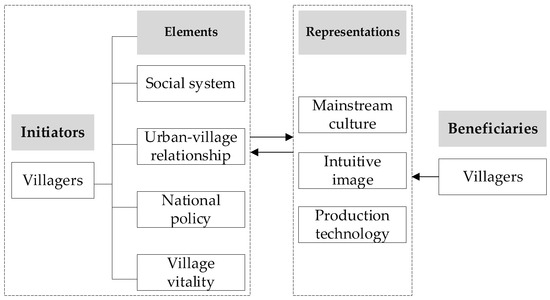
Figure 1.
Construction process of rural communities.
This paper specifically delves into village activities, aiming to sustain various aspects: (1) Residential activities. These encompass the construction of public housing, educational institutions, healthcare facilities, and other public service amenities. (2) Religious activities. Involving the establishment of temples, hosting diverse ceremonies, celebrations, etc., catering to the religious needs of the village inhabitants. (3) Economic activities. Encompassing the construction of infrastructure like bridges, roads, ferries, tea kiosks, and other foundation facilities. Additionally, initiatives related to water conservation, irrigation, flood control, and collective vigilance among villagers to prevent theft or destruction of livestock. Moreover, there are self-protection measures implemented within the village to prevent tax evasion and extortion. (4) Activities upholding local order and morality. This involves the mediation and arbitration of local disputes, formulated collectively by the gentry and civilians, and the implementation of “township regulations”, among other initiatives aimed at maintaining local order and morality. (5) Local defense activities. Undertaken to ensure the defense and security of the village.
2.2. Different Stages in the Evolution of Rural Construction Community
Within villages, historical knowledge and the era’s environment manifest more realistic characteristics than conventional construction knowledge. Consequently, the historical regional environment emerges as a profoundly reflective knowledge system within this paper. It offers valuable insights into the motivations and foundational aspects of human thought and behavioral evolution [32]. By tracing the evolution of social system types, this study delineates the historical evolution process into five distinct but typical stages. Each stage emphasizes the influential trajectory of different socioeconomic patterns on the rural construction community. The identified stages in the study of the rural construction community encompass the following: (1) the era of traditional agricultural civilization; (2) the era of collective civilization; (3) the era of rural industrialization; (4) the era of village differentiation; and 5. the era of rural revitalization (Figure 2). Presently, rural contraction presents a severe challenge. Following the post-village differentiation stage, China’s villages have entered a phase characterized as “comprehensive rural revitalization”. From the cultural landscape perspective, the entire interpretive process aims to delve into the cultural essence of the rural construction community. It endeavors to discuss the sustainable evolution of this cultural core throughout the aforementioned stages.
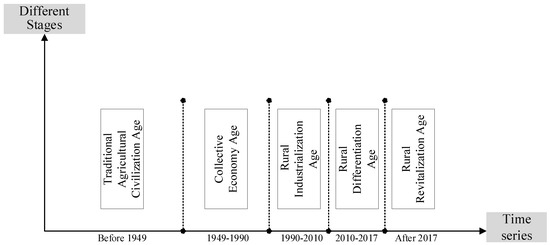
Figure 2.
Different stages in the evolution of rural construction community.
2.3. Analysis Method and Steps
2.3.1. Evolution Process of Rural Construction Community
In the cultural ecology perspective, constructing rural communities constitutes the core characteristic elements of China’s rural cultural geography. It controls the magnitude of changes in agricultural production and its adaptive value in rural areas, thereby generating significant social impacts on productivity. This process leads to the formation of new social systems, achieving the reintegration of constructing rural communities and ultimately driving the development and changes in rural living environments (Figure 3).
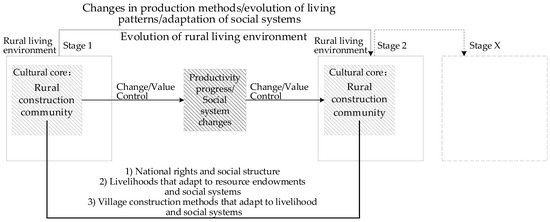
Figure 3.
Adaptation process of rural living environment and composition of rural community construction.
Considering China’s rural environment and the mechanisms behind constructing communities, the composition of rural community construction includes: (1) State authority and social structure: expressed through rural economic and social systems. (2) Livelihood methods adapting to resource endowments and social systems: expressed through dominant types of industries and production levels. (3) Village construction methods adapting to livelihood methods and social systems: expressed through village construction philosophies and spatial patterns.
These components collectively contribute to the formation and functioning of rural communities, reflecting a symbiotic relationship between the environment, social systems, and livelihoods within the rural context.
2.3.2. Analysis of the Coupling of ‘Ecology-Institution-Livelihood’ within the Rural Community Construction
Based on the analysis of historical changes, interpreting the interactive process of the three-dimensional open system—‘material-social-cultural’—in rural community building helps accumulate experiences for historical analysis, ultimately constituting the final goal of historical process research. The rural community building is an amalgamation of social organization and spatial systems. Integrating Prasenjit Duara’s concept of the ‘comprehensive cultural network,’ this article further explores the connections between political institutions, village societies, modes of production, and rural settlements within the rural community building [33]. Specifically, it aims to unravel the transitional process of the coupled relationship between ‘ecology-institutions-livelihoods’.
The livelihood is influenced by ecological services and social systems. Ecological services refer to the various benefits humans obtain from ecosystems, while social systems are enduring social relations based on factors such as culture, trust, and efficiency. Therefore, livelihood represents the fundamental way and ability for farmers to sustain their own existence by relying on ecological resources and social systems. In the coupling relationship of ‘ecology-institution-livelihood,’ the response of livelihood to ecological services and social systems is an embedded relationship. The embedded subject is ‘agricultural/commercial economic behavior,’ and the embedded object is ‘rural social relations.’ Livelihood modes are an entity embedded in ecological services and a system embedded in social relations. Entity embedding represents the resource endowment exchange between livelihood modes and regional ecological services, which constitutes the essence of rural areas. Social relations signify the relative stable state of social life and social system regularities. System embedding refers to the overall relationship structure constructed by livelihood modes and social relations in physical and broader non-physical spaces. Often, there exists mutual adaptation and interdependence between the two subjects of system embedding. Ecological services provide legal justice for institutional determination, while institutions offer efficiency guarantees for ecological utilization. The coupling relationship of ‘ecology-institution-livelihood’ is illustrated in Figure 4.
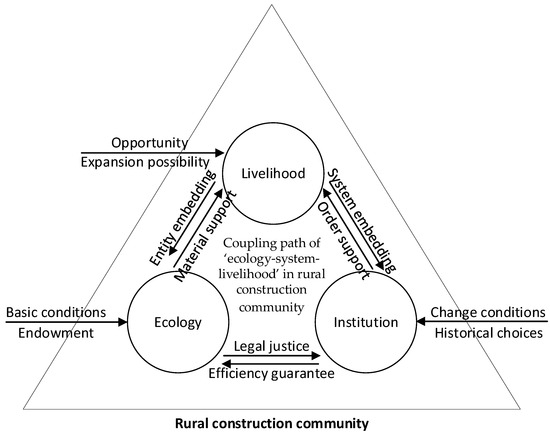
Figure 4.
The coupling framework of ‘ecology-system-livelihood’ within the rural construction community.
2.3.3. Content Framework of This Article
In response to the crises and challenges facing rural construction communities in the present era, aimed at analyzing the evolution process, constituent elements, and internal coupling relationships of these communities, with typical villages within China as the research subjects. Firstly, utilizing the methodology and theories of cultural ecology, the rural construction community is viewed as a complete system. The evolutionary process is categorized into five stages based on social systems. Revealing the adaptive evolution of the rural construction community from the perspectives of rural productivity and technological changes, this exploration seeks to uncover underlying patterns. Building upon this foundation, with the goal of analyzing the coupling pathways of ‘ecology—institution—livelihood,’ this aims to expound upon the interrelationships between the current period (rural alienation and rural revitalization) and the interaction among rural resource patterns, social structures, and economic forms. This serves to achieve an expanded understanding of the rural human settlement system within a complex and changing environment. Please refer to Figure 5 for specific technical pathways.
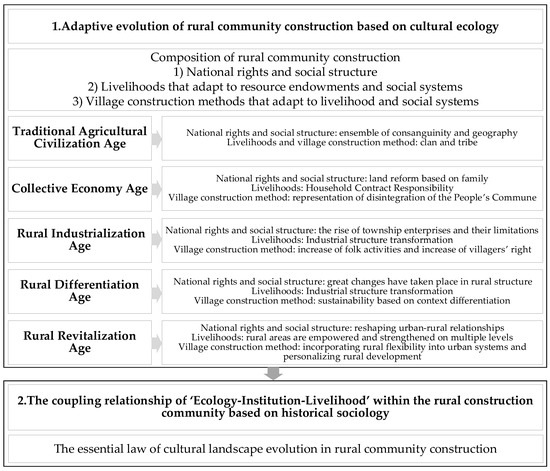
Figure 5.
Fow chart of this article’s method.
3. Adaptive Evolution of Rural Community Construction Based on Cultural Ecology
3.1. Traditional Agricultural Civilization Age: Before 1949
3.1.1. National Rights and Social Structure: Ensemble of Consanguinity and Geography
During this period, the social system comprised primitive and feudal societies, where village communities were grounded in consanguineous and geographical relationships. Historically, compared to the concepts of nation and state, ethnic groups possessed clearer rules governing autonomy and independent development [33]. These ethnic groups encompassed consanguineous, geographical, and industrial categories. In the construction of traditional villages in China, consanguinity and geography formed the foundational bonds that shaped interpersonal relationships within these communities. Therefore, the rural construction community rooted in consanguineous groups and geographical relationships essentially represented an amalgamation of diverse people. The formation process during this era essentially comprised various small communities coming together.
In the era of agrarian civilization, the entire country, from grain production to human settlement, was concentrated in villages, serving as the focal point of governance for all rulers, including the emperor. Concerning the urban–village relationship, villages during this era exhibited dual spatial attributes and social–cultural attributes. This duality fostered a closedness and independence in economic activities and social interactions within well-defined and stable geographical or regional boundaries. Consequently, villages persisted as autonomous cultural and social entities for an extended period. Concurrently, villages acquired a distinct “community” character [9], nurturing a shared set of internal communication norms, a value system, and cultural traditions deeply embedded within the fabric of the “acquaintance society”.
3.1.2. Livelihoods and Village Construction Method: Clan and Tribe
Livelihoods and village construction methods have been historically influenced by clan and tribe dynamics. Consanguineous relationships formed the bedrock of the initial “community”, persisting in various forms across different stages of human social development. However, as consanguineous settlements evolved into geological and other settlement forms, the significance of blood ties in settlements gradually diminished. In contrast, factors such as geographical proximity gained prominence. Undoubtedly, consanguineous settlements corresponding to these groups played pivotal roles in the development and evolution of village settlements [34]. An example of this is the matriarchal society clan and tribe site in Lin Tong, Shaanxi Province, China. Here, a central square is surrounded by five clusters of residential houses, each comprising a dozen rooms and a large communal space, forming the core residential area. While the original settlement’s house were simple in structure, they heavily emphasized communal elements. Furthermore, the settlement’s spatial layout distinctly exhibits ritualistic features connected to worshipping the unknown universe. Additionally, the residential, cemetery, and pottery-making areas represent the fundamental and initial functional divisions within the settlement. Lastly, the construction process and behaviors are clearly characterized by planned, orderly collective efforts (refer to Figure 6).
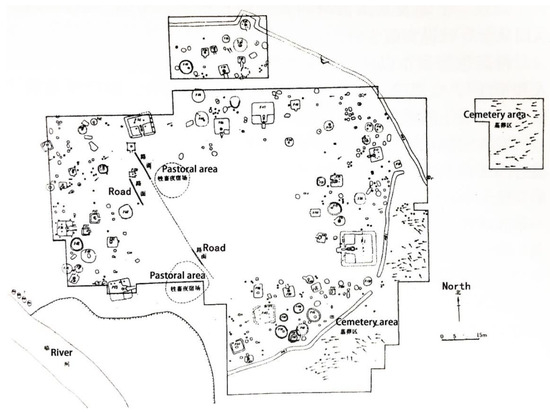
Figure 6.
Distribution of matrilineal clan tribe in traditional agricultural civilization age.
The rural construction community during the agrarian age was formed upon the fusion of consanguinity and geographical factors. Notably, in terms of activity index, behavior density, and architectural diversity, this era witnessed the highest number of village constructions [35]. Guided by the enduring ethos of farming for millennia, the paradigm of rural construction communities has given rise to numerous exemplary villages across China. Presently, the majority of traditional villages observable in China owe their existence to constructions from this historical period. Throughout the agrarian age, these rural construction communities remained pillars of support, nurturing the survival instincts and production beliefs of innumerable peasants.
3.2. Collective Civilization Age: After the Land Reform in 1949–Around 1990
3.2.1. National Rights and Social Structure: Land Reform Anchored in Family
China embarked on formal socialism establishment in 1949, triggering a profound transformation in the relationship between peasants and villages. Following 1949, the comprehensive infiltration of state authority into rural areas led to a reconfiguration of the traditional rural society’s order and governance structure through a series of political movements, such as land reform and collectivization. Village cadres supplanted the traditional gentry class, assuming leadership roles. Land reform eradicated landlord ownership via land redistribution, reshaping rural governance and system standards. The cooperative movement shifted rural land property rights from private to public, mandating the establishment of compulsory collective organizations under the guise of cooperation. The People’s Commune system established a collective property rights system based on the “three levels of ownership and team” in rural areas, institutionalizing the country’s leadership in rural areas. During collectivization, the state became the primary arbiter, controller, and beneficiary of economic factors—a marked departure from the mechanisms of the rural construction community in the agrarian age. The collective organization, formed under state auspices, assumed the role of executing state will and functioned as a local entity responsible for fundamental economic and certain political control functions. This period saw the emergence of challenges to the basic rights of peasants, laying the groundwork for numerous future challenges.
However, despite the robust reconstruction via collectivization in rural areas, the traditional village system persisted. Organizational management, coordination, and cooperation in the countryside remained reliant on this system. The essence of rural construction and governance during this period represents a fusion of “traditional village + collective”. Given the relatively closed nature of villages during collectivization, individuals were deeply concerned about their status within a specific context. Power structures were not solely hierarchical or top–down; some elderly and capable individuals held significant sway over discourse. Under the collectivization system, villages continue to propagate the institutional cultural norms inherited from traditional society. The modes of cooperation between formal power/elite and informal power/elite primarily echoed the norms and structural orders of traditional rural society [36].
Throughout the era of national industrialization, two pivotal systems, namely the People’s Commune system and household registration system, stood as pillars upholding the urban–rural dual structure. Paired with the collectivized village system, these mechanisms firmly tethered peasants to collective lands, impeding their freedom of movement and migration between urban and rural areas. Consequently, peasants were deprived of opportunities to engage in the burgeoning process of industrialization. This dichotomous urban–rural structure hindered China’s urbanization from keeping pace with industrialization, creating a predicament in the relationship between urban and rural areas. During the 1980s–1990s, this conundrum led to a situation where the development of cities and industries came at the cost of sacrificing the countryside [37]. Despite structural changes during the period of national industrialization, China as a whole did not fully shake off its “earthbound” nature. This phase marked the initial structural transformation stage of modern China, yet it remained a “structural transformation without shaking the Local System”. During this time, only individuals with urban household registrations were entitled to receive government-issued food stamps regularly, regardless of their employment status. This phenomenon led to a common saying expressing the future life goal as being “paid by the imperial court”.
3.2.2. Livelihoods: Household Contract Responsibility
The main content of the Household Contract Responsibility System is as follows: based on collectively owned land, the system involves transferring the management of land, large agricultural machinery, and water facilities from the collective to individual households for a considerable period of time. Under this system, the land is contracted to households, allowing named farmers to independently operate and bear the risks of agricultural production. This approach significantly increased the household income derived from agriculture and greatly enhanced agricultural labor productivity. As a result, there was a substantial surplus of agricultural labor, enabling farmers to engage in non-agricultural production and activities. This system also laid the foundation for the emergence of township enterprises.
3.2.3. Village Construction Method: Manifestation of Disintegration of the People’s Commune
The spatial construction of village communities fundamentally manifests in the distribution of property rights, particularly in collective ownership dominating rural economic activities for an extended period. North [38] highlighted that as a monopolistic organization possessing coercive potential, a collective ownership system can indeed establish any form of property rights and wield significant authority for a duration. However, within a context where organizational costs are not negligible, the state remains subject to economic principles such as transaction costs. Prolonged oppression in rural areas ignited fervor among peasants to innovate within the realm of land property rights. However, executing civil rights in urban areas is challenging, let alone for peasants who have experienced a loss of autonomy [39].
Before the dissolution of the People’s Communes, the overall construction of rural farmers’ residential buildings was generally considered to be in a stagnant phase. After the implementation of the Household Contract Responsibility System, the construction of rural households’ dwellings and the overall living environment of villages entered a phase of recovery. In the wake of reforms and the opening-up policy, rural society experienced a rapid evolution characterized by customary household behaviors and reliance on personal networks to acquire resources. However, this behavior cast a substantial shadow over the modernization of rural social and political relations. The ingrained customary practices within rural communities are gradually shaping the fundamental principles governing social, economic, and even local political relations on a day-to-day basis [40]. These cultural underpinnings significantly contribute to China’s economic inefficiencies and political corruption. This period saw the disintegration of the multi-element fusion within the rural construction community. Political factors played a role in transitioning the rural construction community from a structured social system to a realm dominated by practices and activities, highlighting the importance that peasants placed on personal dignity and acquisition. Notably, there was a discernible trend toward diversification in the construction of rural houses during this era, paralleled by a gradual diversification of village activities—a trend that persists to this day. The rural canteen emerged as the cultural and social nucleus of a village, encapsulating diverse interpersonal relationships and serving as the centerpiece of rural landscape (Figure 7).
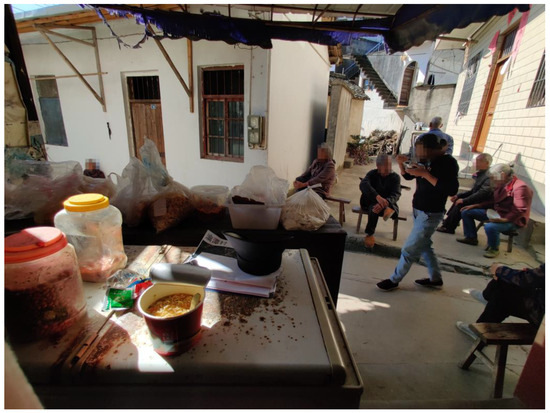
Figure 7.
Villagers in rural canteen (taken in 2021). (The text in the picture is the name of the village).
3.3. Rural Industrialization Age: 1990–2010
3.3.1. National Rights and Social Structure: Emergence and Constraints of Township Enterprises
Following the 1978 reforms, township enterprises proliferated, making China’s transition into rural industrialization. The structural shift during this period stemmed from reforms granting economic rights to rural areas. The agricultural land system underwent a fundamental change: moving from collective ownership and collective farming during the collectivization era to a “double level management system”, involving collective ownership and family cultivation [41]. This change in the property rights system and production organization facilitated a surge in institutional efficiency, leading to exceptional growth in agricultural production by the mid-1980s [42]. Regarding non-agricultural land, the state introduced the “three permits” policy. This policy permitted peasants to establish enterprises on collective land, utilize their own land for urban and town construction, and allowed collective peasant land to directly enter the market, thereby laying the institutional groundwork for rural industrialization. Simultaneously, it encouraged agricultural restructuring, fostered rural commodity economies, established township enterprises, increased rural spatial production, and facilitated surplus labor transfer.
During the “golden period” of township enterprise development (1978~1996), the added value of the township industry surged from less than 6% to 26% of the GDP. The workforce in township enterprises skyrocketed from 28.27 million to 135 million by 1996, boasting an annual growth rate of 9% Supplementary Materials Data S1. Township and village enterprise expansion not only elevated peasants’ incomes, narrowing the urban–rural divide, but also stimulated overall marketization by competing with state-owned industrial enterprises [43]. The paramount significance of township enterprises lies in integrating peasants into the structural transformation and industrialization processes, emancipating them from prior exclusion. However, the rise in township and village enterprises challenges the fundamental essence of village construction communities. While peasants engage in the modernization process through altered production relations, the core spirit and essential community fabric are fundamentally challenged and disrupted [44].
3.3.2. Livelihoods: Industrial Structure Transformation
However, significant limitations persist in the structural transformation amid rural industrialization. Data from pertinent experiences fail to fully support the transition of the peasant–land relationship during this phase. Despite a declining share of agricultural employment and a subsequent increase in non-agricultural employment, the absolute number of individuals engaged in agricultural labor in China’s rural areas not only failed to decrease, but actually grew. A decade after the onset of rural industrialization, the total number of people involved in agriculture, forestry, animal husbandry, and fishery in China’s rural areas increased from 298 million in 1980 to 324 million in 1990 Supplementary Materials Data S2. Furthermore, the amount of arable land per worker in rural regions decreased rather than increased. Consequently, the “native” mode of rural industrialization and the local transfer model of surplus rural labor inadequately eased the urban–rural tension. Approximately one-third to one-half of the agricultural labor force remained in a state of hidden unemployment during the period of rural industrialization, exacerbating issues of agricultural over-densification.
In terms of village vitality, despite the development of village industrialization during this era, peasants largely remained rooted within their localities, heavily reliant on village enterprises. These enterprises sustained the traditional economic model of “division of labor” within villages. The defining characteristic of village industrialization was that peasants engaged in industrial activities within their hometowns, remaining entrenched within the “local China”. Constrained by the structural limitations in absorbing the labor force during rural industrialization, industry development during this period comprised a blend of “family-based small-scale farming” supplemented by “modern factor input” and concurrent “non-agricultural industry”. This setup, however, fell short of constituting a substantial departure from traditional “family-based small-scale farming” [45]. Even though the relationship between peasants and land loosened to some extent during rural industrialization, with the division of labor still predominantly occurring on local land, peasants continued their attachment to the land, sustaining vigorous village vitality during this period.
3.3.3. Village Construction Method: Rise in Folk Activities and Villagers’ Rights
During this period, notable changes resulted from national policies, primarily the resurgence of family management and the dissolution of the people’s commune system. Economic functions at the village level were largely replaced by political and administrative roles overseen by party branches and village committees. In 1987, China passed and enacted the Organic Law of Villagers’ Committees (for Trial Implementation), granting autonomy to villagers within their villages. Concurrently, after the 1978 reforms and an opening-up of the villages, clan organizations experienced a swift revival nationwide. Activities previously prohibited during the collectivization period, such as ancestor worship, annual meetings, ancestral hall repair, and genealogy compilations, began to resurface and even revive.
With the progression of villager autonomy in rural areas since the 1990s, there has been interaction between grassroots rural organizations and clan entities [46]. Within the village operational system, aside from the village committee and the party branch handling higher-level government duties, the village clan assumes responsibility for specific public properties, managing religious, ceremonial, cultural activities, economic assets, and ethical matters. Over the past decade, numerous non-governmental organizations (NGOs) have emerged in many Chinese villages, including temple fairs, associations for the elderly, committees for infrastructure development like bridges and roads, and more. Broadly speaking, the village system in this stage reflects a practical departure of peasants from local land. Concurrently, as collective power gradually weakens and dissolves, traditional village systems and norms persist and experience a partial renaissance. During this period, the rural construction community primarily took shape through the spontaneous organization and execution of folk activities, marking the emergence of villagers’ rights in their nascent form [47]. Rural building types during this era demonstrated a tendency toward diversity. Villagers constructed residences based on their income, aesthetics, inherited items, and other considerations, contributing to the diverse rural landscape (Figure 8).
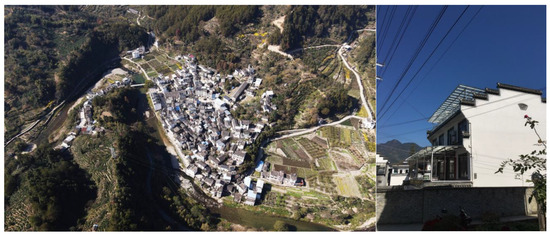
Figure 8.
New houses built by farmers (taken in 2021).
3.4. Rural Differentiation Age: 2010–2017
3.4.1. National Rights and Social Structure: Profound Changes in Rural Dynamics
Within the urban–rural dual system, substantial shifts have not only altered the close bond between peasants and land, but also transformed the relationship between peasants and villages. Firstly, influenced by the processes of urbanization, the number of villages has significantly dwindled, leading to a reshaped distribution and increased differentiation among villages. While some villages exhibit potential for revitalization, a majority are facing decline [48]. Furthermore, village governance and the norms of informal institutions, like cultural norms, have undergone alterations, signifying an ongoing evolution in the essence of villages as institutional entities [49].
The most noticeable is witnessed in demographic structure. Rural areas have witnessed substantial population outflows, with a rapid decline in the proportion of young and middle-aged residents and a decrease in the number of elites returning to their hometowns. Consequently, the social structure and cultural fabric of rural areas have suffered severe damage [50]. Throughout the process of industrialization and urbanization, most villages have experienced varying degrees of population migration outward. For instance, in She County, located in the south of Anhui Province, five villages (Yuetan Village, Yuekeng Village, Xiyuan Village, Guxi Village, Zhao Village) (Figure 9) were chosen as survey sites due to their significant migrant populations. These five villages have attracted more migrant populations due to successful rural tourism development, especially during peak tourist seasons such as March–June and September–November in Huizhou. However, the insufficient number of young and middle-aged residents staying in the village necessitates considerable support from migrant populations to sustain the village’s tourism operations. Even the charter drivers involved in our research are part of the migrant populations supporting these efforts.
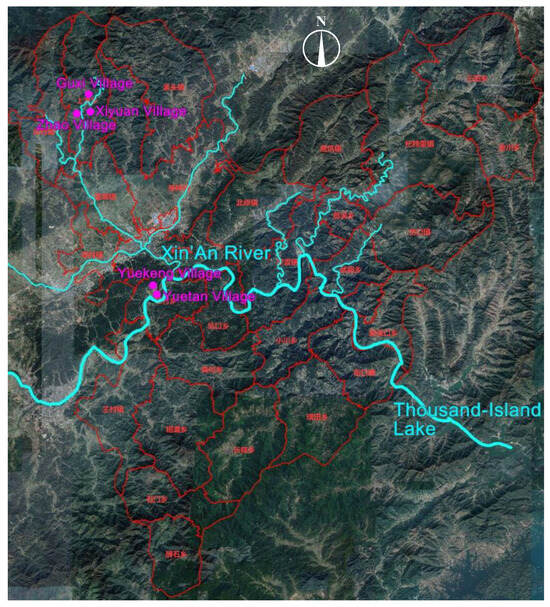
Figure 9.
Five villages facing a large population loss in She County, Anhui Province (The text in the picture is the name of the village).
By means of field interviews and telephone interviews, between September 2020 and July 2021, a total of 143 60-year-old elderly people were surveyed four times (the on-site investigation process is divided into three sections: the first investigation was conducted in November 2020, the second investigation was conducted in June 2021, and the third investigation was conducted in November 2021). The specific survey targets are shown in Table 1.

Table 1.
Basic information of survey targets.
As discussed earlier, a generational divide among migrant peasants has emerged. The first generation of peasants, born in the 1950s, 1960s, and 1970s, sent money back to the village and contributed to building new houses, thereby preventing the village from deteriorating. However, the second generation, born in the 1980s and 1990s, chose not to return to the village after leaving. Instead, their financial resources remained in the city. This generation moved to urban areas, invested in city real estate, and showed no intention of returning their family’s future to the village. This ongoing trend of people leaving rural areas and their capital not returning could lead to further decline for many villages (Figure 10).
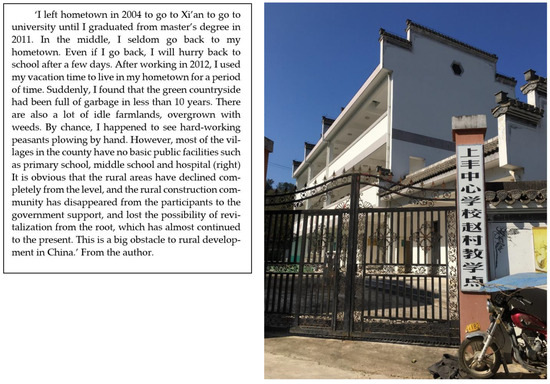
Figure 10.
The new primary school gate is locked after population loss (taken in 2021) (The text in the picture is the name of the school).
3.4.2. Livelihoods: Industrial Structure Transformation
Following the decline in the peak period of village and town enterprises, notable disparities between urban and rural areas became evident, showcasing distinct decentralization and diversification trends. Villages exhibited notably feeble institutional collective actions, necessitating a determined and processed approach to ascertain the pattern of rural construction communities. However, there was no significant breakthrough achieved in the country during this period. The imbalance in civil rights between urban areas and villages directly or indirectly resulted in chaotic and inefficient resource allocation. This imbalance led to qualitative fragmentation across productivity, governance, and cultural independence (Table 2). Consequently, communities in villages are grappling with a sense of alienation.

Table 2.
Assessment framework for the differences in building communities between rural and urban areas.
Another crucial aspect to consider is the impact of rural hollowing. This phenomenon has led to a gradual weakening of basic social connections among villagers and between villagers and village organizations. The diminishing “social capital”, rooted in consanguineous, geographical, and human relationships, has been notable. Wheeler proposed a notion that is more oriented toward exploring positive interpretations of local history and heritage activities, emphasizing a non-political and “productive” or “mobile” approach [51]. This approach is particularly accommodating for the elderly, the vulnerable, women, and children who are left behind due to the significant outflow of labor. They often face constraints in terms of consciousness, ability, resources, and support. The collective consciousness and collaborative abilities of villagers, as well as the cohesion of the entire village community, have witnessed a considerable decline. While the “decline” in many villages seems inevitable, the social capital that embodies relationships among villagers is not prone to an immediate “death” and may persist for an extended period. There remains a possibility for villages to collectively provide public goods through cooperation, despite these challenges.
During this period, the industrial structure in some rural areas shifted from the traditional economy toward a planned industrial economy, modernization, and globalization. However, this transition was not uniform, and there were significant disparities between economically developed regions and underdeveloped ones. Rural areas in underdeveloped regions are seeking ways to narrow the gap by attempting to achieve urban–rural integration and development.
3.4.3. Village Construction Method: Emphasizing Sustainability through Contextual Differentiation
The prevailing village context demands a reimagining of social relations between urban and rural areas. The weaker (village) entities must strive to emancipate themselves from dependence on the stronger (city). Consequently, the social order within villages necessitates a reconstruction [36]. The absence of driving force in most villages poses challenges, especially for those lacking an industrial foundation, making achieving independence a daunting task. Additionally, there exists a disjointedness between the driving forces guiding village development. The differential development of village communities, driven by their unique developmental laws, seeks to depart from the traditional linear paths of village urbanization and village industrialization. This proposed construction mechanism operates on the principle of differential reproduction as the symbiotic environment of villages and cities. It classifies the environment as the symbiotic unit, involving factors like capital and culture as the symbiotic matrix, and industry, landscape, and symbol as the symbiotic interface (Figure 11). This approach aims to resolve the power and resource dilemmas faced by village communities by embracing linkage modes and promoting differential development concurrently, reflecting an ecological perspective. Concurrently, power differentials among residents have contributed to the neglect of legislative provisions aimed at fostering community participation.
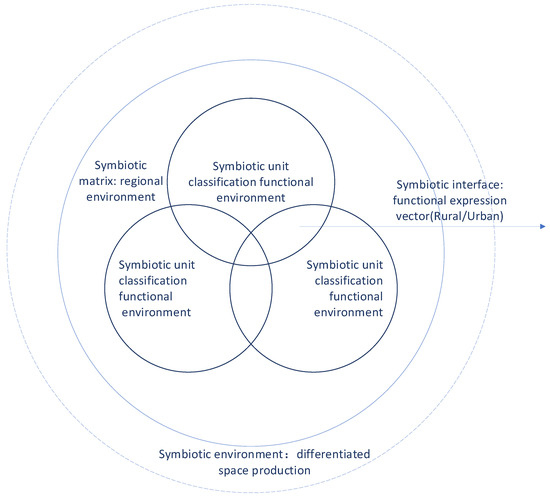
Figure 11.
Sustainable construction model based on context differentiation.
3.5. Rural Revitalization Age: After 2017
3.5.1. National Rights and Social Structure: Reshaping Urban–Rural Relationships
After the proposal of the rural revitalization strategy, various concepts such as “Beautiful Countryside”, “Modern Countryside”, and “Rural Revitalization” have gradually emerged. Essentially, these are all processes of spatial differentiation and reproduction. Within this process, both urban and rural areas seek survival opportunities in the imbalances and differences in production. This applies to both geographical disparities and internal stratification within populations. However, to empower social relations while pushing forward the nature of differentiation that drives spatial production, enabling the weaker parties to break away from dependence on the stronger ones is fundamental for restructuring spatial relationships. Implementing the rural revitalization strategy is advantageous for reshaping urban–rural relationships and promoting two-way flows and equal exchanges of population, land, capital, culture, and other elements between urban and rural areas. The disparities between urban and rural areas that the state seeks to eliminate through power operations are not merely differences in natural forms, but rather the power differentials in resources between rural and urban residents. To truly make rural areas attractive, it is not sufficient to focus solely on industries. It is also crucial to provide supporting guarantees such as healthcare, housing, and education that are roughly equivalent to those available in cities. Achieving this goal requires, as a precondition, the confirmation of farmers’ rights, which should then drive the formulation and implementation of public policies for both urban and rural areas.
3.5.2. Livelihoods: Rural Areas Are Empowered and Strengthened on Multiple Levels
With the empowerment provided, Horinger, Inner Mongolia, as a latecomer rural area, can better access the resources necessary for life and further achieve its goals based on this foundation, enhancing its capabilities on three levels: rural entity, urban–rural relationships, and political systems. At this stage, urban areas providing self-efficacy information from various aspects such as economics, culture, society, ecology, and nature, originating from cities to rural areas. Rural areas feel empowered in this stage, obtaining various policy supports and environmental conditions necessary for rural development through different authorization units like those at county, provincial, and national levels. From the perspective of eliminating status differences and enhancing capabilities, rural areas achieve their goals while demonstrating advantageous features and a leading role in the region, thus achieving urban–rural homogeneity (see Figure 12).
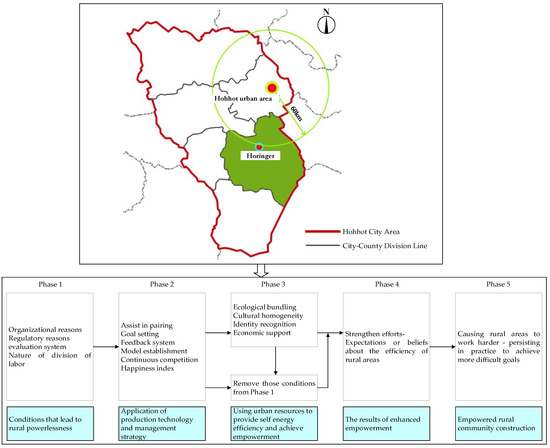
Figure 12.
Five phases of rural empowerment process in underdeveloped areas.
Similar to many rural areas in the central and western regions, Horinger County faces a complex interplay of rural issues. Equity rights in underdeveloped rural areas encompass both wealth equality and identity equality, with wealth equality serving as the foundational aspect. Within the spatial alignment between urban and rural areas, the effective identity advantage of rural regions resides in their traditional agricultural culture and local technology. Since 2010, Horinger County has strategically attracted business units from listed companies such as Mengniu and Mengcao to settle in the area through governmental channels. This has been facilitated by offering land use rights at discounted prices. As a result, local economic development has been stimulated, ensuring a certain degree of wealth fairness for farmers. This empowerment initiative has notably enhanced the effective flow of people, logistics, and information between urban and rural areas.
Under the influence of empowerment, multi-level empowerment is manifested in rural areas in less-developed regions as follows: (1) At the individual level in rural areas, emphasis is placed on self-efficacy development. Based on resource advantages and community strengths, rural areas generate strong intrinsic developmental momentum and possess the ability to awaken individual values, thereby achieving individual empowerment and strengthening. (2) At the regional/organizational level in urban–rural areas, it achieves regional efficiency development. Leveraging the power of government and non-governmental organizations, rural areas tailor their development and planning according to local characteristics such as nature, history, and industrial development. They emphasize differentiation and planning while integrating cultural preservation and inheritance, agricultural production processes, and non-agricultural business processes into the overall capacity building of rural areas. Distinctive towns and villages play a core role in the region, thereby achieving regional organizational empowerment and strengthening.(3) At the macro level, there is widespread development in rural efficiency. Rural development policies, institutional systems, and organizational management continue to improve, removing institutional barriers and universally enhancing rural efficiency. This realizes macro-empowerment and the strengthening of rural regions.
3.5.3. Village Construction Method: Incorporating Rural Flexibility into Urban Systems and Personalizing Rural Development
From the perspective of rural revitalization, relying solely on the government or capital would only yield results in terms of political achievements or capital reproduction. Therefore, it is necessary to mobilize internal rural organizations to address these issues. Whether it is the villages around developed cities or those lagging behind, it is important to objectively view the role of urban capital. Rural areas do not need to reject the impetus of urban capital for the sake of preserving a so-called “original flavor”. Changes in rural production methods, improvements in construction technology, and the efficient transmission of information represent a clear and logically structured spatial transformation in the interaction and feedback between urban and rural areas.
Every action within villages and towns, including renovating houses and adopting new materials, is driven by economic rationale. However, individual economic rationale may not necessarily align with the overall economic rationale of the region. As mentioned earlier, rural areas have already been incorporated into a brand-new capital system as part of urban production sequences. Besides the physical development of rural spaces, achieving sustained value appreciation in rural spaces requires the driving force of urban capital and culture to enhance rural management and operations.
Sociality exists as an inherent fact, and no rural or urban area can exist detached from the symbiotic relationship within the entire social network. Horinger relies on Hohhot as a potential unified entity, leveraging various regional characteristics to create new models of rural individuality. Through the Hohhot and even the Hohhot–Baotou–Erdos–Yulin urban circle, it transforms and combines the production elements and cultural functions between urban and rural areas. Therefore, each township in Horinger County possesses stability and adaptability in the process driven by urban capital. This progressive symbiotic model is evidently superior to revitalization or specialization treated as a unique case for rural areas.
4. The Coupling Relationship of Ecology–Institution–Livelihood within the Rural Construction Community Based on Historical Sociology
4.1. The Process of Coupling Transformation
Evolutionary process under traditional agricultural technologies and production structures, rural areas, based on adaptation to natural environments and resources, were clustered together by kinship and geographical proximity, with relatively small-scale cultivation. The coupling of ecology–institution–livelihood was at a primitive stage, and the spatial structure overlaid a comprehensive effect of production materials, productivity, and the political environment. During the process of rural industrialization, constrained by the technological levels of the era, political–economic systems, and class limitations, the unequal status of urban and rural areas in resource allocation led to the dissolution of the rural construction community, urgently requiring a new incentive mechanism. During this period, rural hamlets were central to the rural construction community, and the connections between settlements were established through social networks. With the advancement of agricultural mechanization in the industrial civilization background, agricultural productivity significantly increased. A new mode of rural governance emerged through government and societal collaboration, demonstrating the flexibility, synergy, and autonomy of rural governance. Particularly after rural revitalization, grassroots rural organizations became a typical governance model balancing and complementing government and society. While the government mainly managed farmer self-governance within communities, it provided support that did not harm the social, cultural, and organizational resilience of rural communities. In agricultural areas, agricultural villages held a considerable degree of autonomy in guiding rural community cultural revitalization, scientific and technological leadership in rural revitalization, and other agricultural science and technology fields.
4.2. Comparison of Rural Cultural Landscape in 5 Stages
Based on formation mechanism of rural construction communities, we did this comparison (Table 3).

Table 3.
Comparison of rural landscape in 4 stages.
We can see that villages are seriously alienated now and some regions are undergoing revitalization, so we raised the following question.
4.3. Who Holds the Primary Role in Rural Construction Development?
In the realm of rural construction, civilians ideally stand as the natural backbone for shaping both urban and rural living environments. However, due to factors such as capital, rights, and social divisions of labor, the civilian position and role in construction are indirect, necessitating a transformational process. Yet, in rural areas, the dynamics differ significantly. Firstly, the relationship between land and inhabitants in villages diverges from that in urban centers and towns. As a longstanding agricultural nation, successive political leaders have endeavored to foster a harmonious bond between peasants and their land [52]. Consequently, this has forged China’s distinct agrarian culture and clan ethos rooted in the land itself. Over time, peasants have cultivated geographically interlinked village communities and living environments through their daily lives and labor. It can be contended that the profound connection between villagers and their specific lands drives them to perceive the construction of their homes and settlements as integral parts of their lives—a sentiment that persists substantially in contemporary society. Leveraging the existing national policy of rural autonomy, the establishment of grassroots organizations in rural communities—endorsed and trusted by the villagers themselves—facilitates robust participation by villagers in advancing their rights. The agency of peasants within the community construction movement is multifaceted and consequently engenders a complex relationship with resistance to neoliberalism, notably in aspects such as information dissemination.
“In the survey conducted in She County, nearly every residential compound features a chrysanthemum dryer, despite the fact that these individual household straw-burning practices may fall short of meeting environmental standards (Figure 13). Chinese peasants inherently possess a dedication that compels them, even within legal constraints, to resourcefully manifest their aspirations. Although such construction practices are less prevalent in today’s rural China, they stand as evidence that the essence of rural society remains unaltered”—as quoted by the author.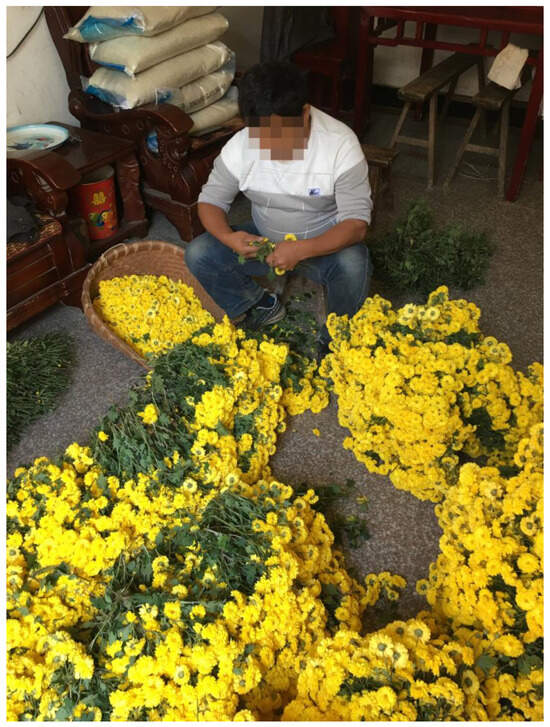 Figure 13. The villagers picked the fresh chrysanthemums and put them into the drying equipment (taken in 2020).
Figure 13. The villagers picked the fresh chrysanthemums and put them into the drying equipment (taken in 2020).
5. Discussion and Conclusions
5.1. Discussion
5.1.1. Forming an Interpretation of Rural Areas Based on Constructing a Community
The theory of community is a traditional perspective on governance and ruling in China. The basic structure of rural construction of a community consists of three identifications with spatial and boundary tendencies: state authority, livelihood methods, and village construction methods. Rural settlements, under the continuous operation of constructing a community, are dynamic and evolving organizations responsible for regional functions, efficient resource allocation, and the social scientific governance in rural areas. This includes the continual improvement of social systems, the gradual publicization and equalization of economic resources, the clarification of responsibilities and rights among community members, the symbiotic relationship between people and land in the spatial layout of villages, and the legalization of community management mechanisms.
This article clarifies the role of constructing a rural community as the fundamental unit of rural society. It regards the community as a local practice, constructing economic relationship networks between people based on state institutions and material production resources, along with local social orders. The rural construction of a community is a governing principle above both the economic and social spheres. Its description of the evolutionary process provides a strong practical interpretation of the concept of rural areas, enabling a more profound understanding.
5.1.2. Systematic Understanding of Rural Construction Community
It is possible to distinctly outline the developmental history of oases in arid regions. In the evolution of the rural construction community, rural productivity holds a predominant position. The structure of social relations originates from the structure of production relations. Productivity and social relationships together constitute the underlying mainline of the complex transformation of the rural construction community. The rural construction community is closely related to daily practices such as resource regulation, rights adjustment, economic production, and village development, which are associated with rural revitalization. Therefore, the relationships between internal elements of the rural construction community are not mere tangible connections, but comprise a complex network of relationships. The historical analysis of the ecology–institution–livelihood transition in the rural construction community expands the cognitive domain of rural environments and emphasizes process and dynamic mechanism analysis. This broader understanding provides a deeper insight into rural human settlement systems within complex changing contexts.
5.1.3. Challenges and Limitations
Considering the evolution perspective, the influence wielded by participants within the rural construction community on the social system is gradually expanding. Simultaneously, as China’s population quality continues to improve, the autonomous involvement of villagers in the rural construction community is deepening. Nevertheless, regional disparities and gaps persist, with varying roles played by the rural construction community in village rejuvenation and reconstruction. Future endeavors should aim to better recognize the adaptability of diverse village construction entities. For researchers in social sciences or urban and rural planning, the study of rural construction communities transcends the mere rectification of physical environments or redefining rights. Instead, it ought to foster increased potential for village rejuvenation and ecological integration. Embracing the rural construction community as a systemic concept in this new era necessitates acknowledging its complex and diverse content, encompassing political, capital, industrial, rights-based, cultural, and systemic aspects. These elements are closely linked to the advancement of urbanization and the evolution of economic network in the surrounding areas. The subsequent analytical step should focus on deciphering the spatial configuration of rural areas and delving into the representation of human–land relationships within communities. Moving forward, there is a pressing need to explore a more equitable approach to rural revitalization, necessitating broader contextual thinking, more profound field investigations, and a richer array of empirical examples.
5.2. Conclusions
5.2.1. The Element Composition and Evolutionary Changes in Village Construction
- (1)
- Due to fundamental productivity limitations like transportation, villages during farming periods often find themselves constrained, primarily focusing on agricultural pursuits. Consequently, the arrangement and structure of villages reflect the features aligned with the traditional level of agricultural productivity: an inherent organic amalgamation of production and daily life, fostering a harmonious symbiotic relationship between humanity and the land (Figure 14).
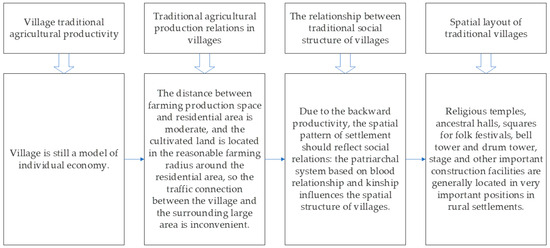 Figure 14. The social and cultural structure of villages in the period of farming.
Figure 14. The social and cultural structure of villages in the period of farming.
- (2)
- Post-liberation, the construction of village communities signifies a fusion between natural elements and human intervention. During this phase, villages have notably distanced themselves from their reliance solely on land, diverging from the traditional agricultural village development trajectory. Presently, village construction and advancement predominantly hinge upon commercial gains. Consequently, villages exhibit a blend of characteristics, encompassing ancient patriarchal clan concepts, a modern production ambiance, as well as sentiments pertaining to life and leisure. The spatial components within a production-oriented village community directly influence and are influenced by the operation of social relations, significantly impacting the fabric of social dynamics. Elements such as residences, thoroughfares, water systems, ancestral halls, and workshops within the village community serve as conduits for expressing social relations, collectively constituting the elements that shape the socialized space within village community, thereby upholding rural social order.
Utilizing residential and production spaces as focal points, streets, water systems, and ceremonial spaces serve an educative purpose, culminating in the construction of the village through the amalgamation of material spatial elements. The village community, through its integration of family–housing–production continuity and the systematic arrangement of material spaces in the context of collective production, exhibits distinct characteristics of regionalized social space (Figure 15).
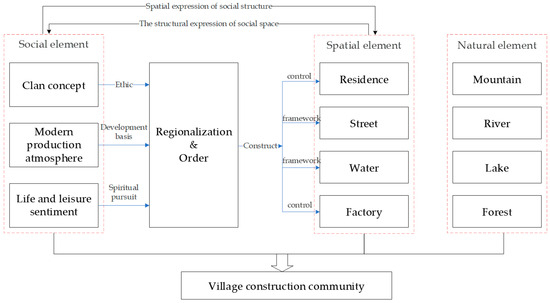
Figure 15.
Village construction community in collective production times.
- (3)
- Beyond 2017, while many villages encounter decline, certain rural construction communities exhibit increased resilience and adaptability. A resilient rural construction community embodies the concurrent presence of diverse stakeholders, functioning as carriers within the regional system space, thereby establishing a sustainable competitive framework. Specific functions gradually evolve toward specialization, generating synergy with other functions. This specialized advantageous function ultimately epitomizes the core competitiveness within the regional system. Within this developmental framework of competition and coexistence, the emphasis is not on alienation or detachment but rather signifies a village structure brimming with enhanced vitality (Table 4).
 Table 4. Comparison between the former village construction community and the flexible village construction community.
Table 4. Comparison between the former village construction community and the flexible village construction community.
5.2.2. Considering the Rural Construction Community as an Unforeseen Entity
The essential core of rural settlements defies complete deconstruction due to its nature, which evades strict causal analysis. Instead, it comprises numerous unforeseen entities characterized by strong contingency. Furthermore, the potential impact of population mobility remains uncertain regarding whether it might reintroduce a stranger-based model for interpersonal relationships to rural areas or generate entirely new social norms and public–private orders. Within this framework of contingency-based organization, the rural construction community, blending elements of modernity and native essence, emerges as a viable path forward. It encompasses three distinct spatial forms existing nonlinearly within villages: modern space, modern–local space, and local space. The materialized state of space denotes the tangible expression of different spatial attributes. Modern space embodies direct value augmentation through spatial elements, exemplified by logistics parks, commercial buildings, etc. Meanwhile, modern–local space is value-centric, emphasizing space as a conduit for both value addition and cultural heritage, such as school buildings, cultural centers, tourist establishments, etc. The rural landscape finds expression through village settlements, agricultural parks, and traditional folk customs (Figure 16). The curvature trend signifies the dynamism and periodicity inherent in spatial value.
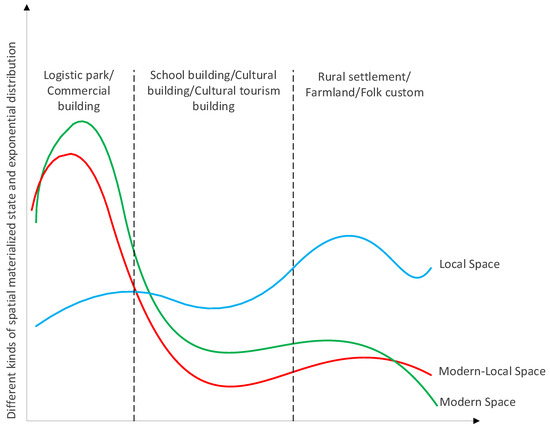
Figure 16.
Different kinds of spatial materialized state and exponential distribution.
Supplementary Materials
Data S1: China Statistical Yearbook 2003, compiled by State Statistical Bureau of the people’s Republic of China. China Statistical Yearbook—2003 Published (https://www.stats.gov.cn/). Data S2 Data source: China Statistical Yearbook 2004, compiled by State Statistical Bureau of the people’s Republic of China. China Statistical Yearbook—2004 has published (https://www.stats.gov.cn/). Both links are accessed 27 December 2023.
Author Contributions
Conceptualization, K.R. and T.W.; methodology, K.R.; software, K.R.; validation, K.R. and T.W.; formal analysis, K.R.; investigation, K.R.; resources, K.R.; data curation, K.R.; writing—original draft preparation, K.R.; writing—review and editing, T.W.; visualization, T.W.; supervision, T.W.; project administration, T.W.; funding acquisition, K.R. and T.W. All authors have read and agreed to the published version of the manuscript.
Funding
This research was funded by “National Social Science Foundation Project (20BMZ131)”, “Ministry of Education Humanities and Social Sciences Research Youth Fund Project (23YJC850016)”, “2023 Ordos Social Science Research Project (2023p258)”, “Research Project on Development of Culture and Tourism in Inner Mongolia Autonomous Region (2023-WL0029)” and “Development Plan for Innovation Teams in Higher Education Institutions in Inner Mongolia Autonomous Region (NMGIRT220)”.
Data Availability Statement
Data are contained within the article and Supplementary Materials.
Acknowledgments
We thank the People’s Government of She County, Anhui Province, China, for providing opportunities for government and social interviews. All figures are drawn and taken by the authors.
Conflicts of Interest
The authors declare no conflict of interest.
References
- Li, Y.; Qiao, L.; Wang, Q.; Dávid, K. Towards the evaluation of rural livability in China: Theoretical framework and empirical case study. Habitat Int. 2020, 105, 102241. [Google Scholar] [CrossRef]
- Li, Y.; Liu, Y.; Long, H.; Cui, W. Community-based rural residential land consolidation and allocation can help to revitalize hollowed villages in traditional agricultural areas of China: Evidence from Dancheng County, Henan Province. Land Use Policy 2014, 39, 188–198. [Google Scholar] [CrossRef]
- Liu, Y. Introduction to land use and rural sustainability in China. Land Use Policy 2018, 74, 1–4. [Google Scholar] [CrossRef]
- Chen, H.; Hu, Y. Finding Community Structure and Evaluating Hub Road Section in Urban Traffic Network. Procedia Soc. Behav. Sci. 2013, 96, 1494–1501. [Google Scholar] [CrossRef][Green Version]
- Barraket, J.; Eversole, R.; Luke, B.; Barth, S. Resourcefulness of locally-oriented social enterprises: Implications for rural community development. J. Rural. Stud. 2019, 70, 188–197. [Google Scholar] [CrossRef]
- Steiner, A.; Atterton, J. Exploring the contribution of rural enterprises to local resilience. J. Rural Stud. 2015, 40, 30–45. [Google Scholar] [CrossRef]
- Chakraborty, S.; Avtar, R.; Raj, R.; Minh, H.V.T. Village Level Provisioning Ecosystem Services and Their Values to Local Communities in the Peri-Urban Areas of Manila, The Philippines. Land 2019, 8, 177. [Google Scholar] [CrossRef]
- Primdahl, J.; Eetvelde, V.V.; Pinto-Correia, T. Rural Landscapes—Challenges and Solutions to Landscape Governance. Land 2020, 9, 521. [Google Scholar] [CrossRef]
- Fei, S.-L. Peasant Life in China; Routledge & Kegan Paul: London, UK, 1980. [Google Scholar]
- Yates, D. “Community Justice”, Ancestral Rights, and Lynching in Rural Bolivia; SAGE Publications Inc.: Thousand Oaks, CA, USA, 2020. [Google Scholar]
- Kumpulainen, K.; Soini, K. How Do Community Development Activities Affect the Construction of Rural Places? A Case Study from Finland. Sociol Rural. 2019, 59, 294–313. [Google Scholar] [CrossRef]
- Shahraki, S.Z.; Hosseini, A.; Sauri, D.; Hussaini, F. Fringe more than context: Perceived quality of life in informal settlements in a developing country: The case of Kabul, Afghanistan. Sustain. Cities Soc. 2020, 63, 102494. [Google Scholar] [CrossRef]
- Shucksmith, M. Disintegrated Rural Development? Neo-endogenous Rural Development, Planning and Place-Shaping in Diffused Power Contexts. Sociol Rural. 2010, 50, 1–14. [Google Scholar] [CrossRef]
- Vasstrøm, M.; Normann, R. The role of local government in rural communities: Culture-based development strategies. Local Gov. Stud. 2019, 45, 848–868. [Google Scholar] [CrossRef]
- Dinnie, E.; Fischer, A. The Trouble with Community: How ‘Sense of Community’ Influences Participation in Formal, Community-Led Organisations and Rural Governance; John Wiley & Sons, Ltd.: Hoboken, NJ, USA, 2020. [Google Scholar]
- Sabet, N.S.; Khaksar, S. The performance of local government, social capital and participation of villagers in sustainable rural development. Soc. Sci. J. 2020, 1–29. [Google Scholar] [CrossRef]
- Steward, J.H. Theory of Culture Change; University of Illinois Press: Champaign, IL, USA, 1972. [Google Scholar]
- Durkheim, E. The Division of Labor in Society (1893); Blackwell: Oxford, UK, 2000; pp. 37–66. [Google Scholar]
- Tada, M. Language and imagined Gesellschaft: Mile Durkheim’s civil-linguistic nationalism and the consequences of universal human ideals. Theory Soc. 2020, 49, 597–630. [Google Scholar] [CrossRef] [PubMed]
- Steffel, V. A History of Civilizations; Penguin Pr.: London, UK, 1994. [Google Scholar]
- Ratzel, F.; Stehlin, S.A. Sketches of Urban and Cultural Life in North America; Rutgers University Press: New Beunswick, NJ, USA, 1988. [Google Scholar]
- Font, C.; Padró, R.; Cattaneo, C.; Marull, J.; Farré, M. How farmers shape cultural landscapes. Dealing with information in farm systems (Vallès County, Catalonia, 1860). Ecol. Indic. 2020, 112, 106104. [Google Scholar] [CrossRef]
- Cháirez-Garza, J.F. BR Ambedkar, Franz Boas and the Rejection of Racial Theories of Untouchability. South Asia J. South Asian Stud. 2018, 41, 281–296. [Google Scholar] [CrossRef]
- Redfield, R. Peasant society and culture: An anthropological approach to civilization. Am. Sociol. Rev. 1956, 21. [Google Scholar]
- Frankfurter, D. The Great, the Little, and the Authoritative Tradition in Magic of the Ancient World. Archiv. Relig. 2015, 16, 11–30. [Google Scholar] [CrossRef]
- Radcliffe-Brown, A.R.; Kuper, A. The Social Anthropology of Radcliffe-Brown; Routledge: Oxfordshire, UK, 2004. [Google Scholar]
- Kvartiuk, V.; Curtiss, J. Participatory rural development without participation: Insights from Ukraine. J. Rural Stud. 2019, 69, 76–86. [Google Scholar] [CrossRef]
- Armstrong, A.; Stedman, R.C. Understanding Local Environmental Concern: The Importance of Place: Local Environmental Concern and Place. Rural Sociol. 2018, 84, 93–122. [Google Scholar] [CrossRef]
- Ye, F.; Qin, S.; Nisar, N.; Zhang, Q.; Tong, T.; Wang, L. Does rural industrial integration improve agricultural productivity? Implications for sustainable food production. Front. Sustain. Food Syst. 2023, 7, 1191024. [Google Scholar] [CrossRef]
- Zhang, Q.; Razzaq, A.; Qin, J.; Feng, Z.; Ye, F.; Xiao, M. Does the Expansion of Farmers’ Operation Scale Improve the Efficiency of Agricultural Production in China? Implications for Environmental Sustainability. Front. Environ. Sci. 2022, 10, 918060. [Google Scholar] [CrossRef]
- Rajpar, H.; Zhang, A.; Razzaq, A.; Mehmood, K.; Pirzado, M.B.; Hu, W. Agricultural Land Abandonment and Farmers’ Perceptions of Land Use Change in the Indus Plains of Pakistan: A Case Study of Sindh Province. Sustainability 2019, 11, 4663. [Google Scholar] [CrossRef]
- van Riper, C.J.; Foelske, L.; Kuwayama, S.D.; Keller, R.; Johnson, D. Understanding the role of local knowledge in the spatial dynamics of social values expressed by stakeholders. Appl. Geogr. 2020, 123, 102279. [Google Scholar] [CrossRef]
- Duara, P. Sovereignty and Authenticity; Rowman & Littlefield Publishers: Washington, DC, USA, 2003. [Google Scholar]
- Akbari, M.; Bahrami-Rad, D.; Kimbrough, E.O. Kinship, fractionalization and corruption. J. Econ. Behav. Organ. 2019, 166, 493–528. [Google Scholar] [CrossRef]
- Wu, C.; Chen, M.; Zhou, L.; Liang, X.; Wang, W. Identifying the Spatiotemporal Patterns of Traditional Villages in China: A Multiscale Perspective. Land 2020, 9, 449. [Google Scholar] [CrossRef]
- Yang, X.; Pu, F. Spatial Cognitive Modeling of the Site Selection for Traditional Rural Settlements: A Case Study of Kengzi Village, Southern China. J. Urban Plan. Dev. 2020, 146, 5020026. [Google Scholar] [CrossRef]
- Liu, Y.; Zhou, Y.; Wu, W. Assessing the impact of population, income and technology on energy consumption and industrial pollutant emissions in China. Appl. Energy 2015, 155, 904–917. [Google Scholar] [CrossRef]
- North, D.C. Structure and Change in Economic History; Norton: New York, NY, USA, 1981. [Google Scholar]
- Yang, Q.L.H. Spatial distribution characteristics and optimized reconstruction analysis of China’s rural settlements during the process of rapid urbanization. J. Rural Stud. 2016, 47, 413–424. [Google Scholar] [CrossRef]
- Zhang, L.; Du, H.; Zhao, Y.; Zhang, X. Effect Mechanisms of Peasant Relocation Decision-making Behaviours in the Process of Rural Spatial Restructuring: The case of Hotan region, China. Sustain. Cities Soc. 2020, 63, 102429. [Google Scholar] [CrossRef]
- Yin, J.; Zhao, X.; Zhang, W.; Wang, P. Rural Land Use Change Driven by Informal Industrialization: Evidence from Fengzhuang Village in China. Land 2020, 9, 190. [Google Scholar] [CrossRef]
- Wang, Y. Institutional interaction and decision making in China’s rural development. J. Rural Stud. 2020, 76, 111–119. [Google Scholar] [CrossRef]
- Liu, S.; Xiong, X. China’s rural institutions and governance since the beginning of the rural reform. China Econ. J. 2018, 11, 259–283. [Google Scholar] [CrossRef]
- Walsh-Dilley, M. Religious Fragmentation, Social Disintegration? Social Networks and Evangelical Protestantism in Rural Andean Bolivia. Qual. Sociol. 2019, 42, 499–520. [Google Scholar] [CrossRef]
- Shen, Y.; Hu, Y. Emotional Labour in a Translocal Context: Rural Migrant Workers in China’s Service Sector. Soc. Cult. Geogr. 2020, 23, 521–538. [Google Scholar] [CrossRef]
- Li, X.; Wang, Y.; Song, Y. Unraveling land system vulnerability to rapid urbanization: An indicator-based vulnerability assessment for Wuhan, China. Environ. Res. 2022, 211, 112981. [Google Scholar] [CrossRef] [PubMed]
- Bisaga, I.; Parikh, P.; Loggia, C. Challenges and Opportunities for Sustainable Urban Farming in South African Low-Income Settlements: A Case Study in Durban. Sustainability 2019, 11, 5660. [Google Scholar] [CrossRef]
- Beaumont, E.; Brown, D. ‘It’s the sea and the beach more than anything for me’: Local surfer’s and the construction of community and communitas in a rural Cornish seaside village. J. Rural Stud. 2018, 59, 58–66. [Google Scholar] [CrossRef]
- Ka-Yin, L.A.; Anthony, A.R. Naturalizing people, ethnicizing landscape: Promoting tourism in China’s rural periphery. Asian Geogr. 2018, 35, 177–196. [Google Scholar]
- Miao, S.; Heijman, W.; Zhu, X.; Qiao, D.; Lu, Q. Income Groups, Social Capital, and Collective Action on Small-Scale Irrigation Facilities: A Multigroup Analysis Based on a Structural Equation Model. Rural Sociol. 2016, 83, 882–911. [Google Scholar] [CrossRef]
- Wheeler, R. Local history as productive nostalgia? Change, continuity and sense of place in rural England. Soc. Cult. Geogr. 2016, 18, 466–486. [Google Scholar] [CrossRef]
- Chambers, R. Rural Development; Wiley: Hoboken, NJ, USA, 1983. [Google Scholar]
Disclaimer/Publisher’s Note: The statements, opinions and data contained in all publications are solely those of the individual author(s) and contributor(s) and not of MDPI and/or the editor(s). MDPI and/or the editor(s) disclaim responsibility for any injury to people or property resulting from any ideas, methods, instructions or products referred to in the content. |
© 2023 by the authors. Licensee MDPI, Basel, Switzerland. This article is an open access article distributed under the terms and conditions of the Creative Commons Attribution (CC BY) license (https://creativecommons.org/licenses/by/4.0/).